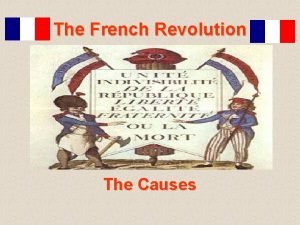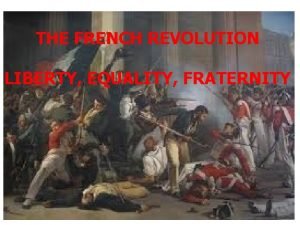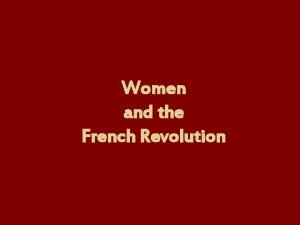AP World History The French Revolution Period 4




























- Slides: 28

AP World History: The French Revolution Period 4


I The Old Regime (Ancien Regime) A) Old Regime – sociopolitical system which existed in most of Europe during the 18 th century B) At this time many European countries were ruled by absolute monarchs. C) France’s social hierarchy was divided into three estates.

II Causes of the French Revolution A) France’s economy was declining ü Peasant farmers of France bore the burden of taxation ü The price of bread was skyrocketing. ü King Louis XVI lavished money on himself and residences like Versailles. Queen Marie Antoinette was seen as a wasteful spender. (Thus the rumor of her saying “Let them eat cake”, which historians think she never actually said) ü The government funds were also depleted due to aiding the American Revolution. B) Enlightenment philosophes questioned the divine right of monarchs. C) Influence of the American Revolution!

The French Monarchy Marie Antoinette was born in Vienna, Austria 1755 to the Holy Roman Emperor Francis I and Habsburg Empress Maria Theresa. She was 14 years old when she married the future French King Louis XVI.

Causes of the French Revolution Continued… C) In the fall of 1786, Louis XVI’s controller general, Charles Alexandre de Calonne proposed a universal land tax from which the privileged classes would no longer be exempt. To prevent the nobles from revolting, the king summoned the Estates-General; an assembly representing France’s clergy, nobility and middle class–for the first time since 1614. The meeting was scheduled for May 5, 1789; and delegates of the three estates from each locality would compile lists of grievances to present to the king. The Third Estate represented 98% of the people but could still be outvoted by the other two bodies. Prior to the May 5 meeting, the Third Estate began to mobilize support for equal representation and the abolishment of the noble veto–in other words, they wanted voting by head and not by status. However, the nobles did not want to give up their privileges under the “ancien regime”.

Causes of the French Revolution Continued… D) On June 17, the 3 rd Estate met alone and formally adopted the title of the National Assembly. Louis XVI locked the National Assembly out of the Estates-General meeting. 3 days later, the National Assembly met in a nearby indoor tennis court and took the Tennis Court Oath, vowing not to leave until constitutional reform had been achieved. On June 23, 1789, Louis XVI relented. He ordered the 3 estates to meet together as the National Assembly and vote by population, on a constitution for France. “The National Assembly, considering that it has been summoned to establish the constitution of the kingdom, to effect the regeneration of the public order, and to maintain the true principles of monarchy… Decrees that all members of this Assembly shall immediately take a solemn oath not to separate, and to reassemble wherever circumstances require, until the constitution of the kingdom is established and consolidated upon firm foundations; and that, the said oath taken, all members and each one of them individually shall ratify this steadfast resolution by signature. ”


III The Storming of the Bastille and Great Fear On June 12, as the National Assembly continued to meet at Versailles, Parisians panicked due to rumors of an impending military coup. On July 14 rioters stormed the Bastille fortress in an attempt to secure gunpowder and weapons; many consider this event, as the start of the French Revolution. The Bastille was built in 1370 and was first used as a state prison in the 17 th century. Most prisoners were imprisoned without a trial under orders of the king. Bernard-Jordan de Launay, the military governor of the Bastille, feared that his fortress would be a target for the revolutionaries and so requested reinforcements, and transferred 250 barrels of gunpowder to the Bastille. On July 13, revolutionaries with muskets began firing at soldiers standing guard. That evening, mobs stormed the Paris Arsenal and acquired thousands of muskets. At dawn on July 14, an armed crowd formed in front of the Bastille. Launay promised he would not open fire on the crowd and showed them that his cannons were not loaded. Ignoring this, a group of 300 men to climb over the outer wall of the courtyard and lowered a drawbridge. Launay ordered his men to open fire…

The Storming the Bastille Continued… Around 3 p. m. , a company of deserters from the French army arrived. The soldiers, hidden by smoke from fires set by the mob, dragged five cannons into the courtyard and aimed them at the Bastille. Launay raised a white flag of surrender over the fortress. Launay and his men were taken into custody, the gunpowder and cannons were seized, and the 7 prisoners of the Bastille were freed. (*The majority of the prisoners had been moved. The capture of the Bastille symbolized the end of the ancien regime peasants looted and burned the homes of tax collectors, landlords and nobles (The Great Fear) exodus of nobles from the country and inspired the National Assembly to abolish feudalism on August 4, 1789.

Bastille Day July 14 th, Paris

IV Drafting a Constitution A) On August 4, the National Constituent Assembly adopted the Declaration of the Rights of Man and of the Citizen, based on the ideas of enlightenment philosophes. Aim to replace the ancien régime with a system based on equal opportunity, freedom of speech, popular sovereignty and representative government. B) Drafting a formal constitution was a challenge as the members of the National Constituent Assembly had to deal with questions such as 1. Who would be responsible for electing delegates? 2. Would the clergy owe allegiance to the Roman Catholic Church or the French government? 3. How much authority would the king, his public image further weakened after a failed attempt to flee in June 1791, retain?

Primary Source: The Declaration of the Rights of Man and of the Citizen Approved by the National Assembly of France, August 26, 1789 The representatives of the French people, organized as a National Assembly, believing that the ignorance, neglect, or contempt of the rights of man are the sole cause of public calamities and of the corruption of governments, have determined to set forth in a solemn declaration the natural, unalienable, and sacred rights of man, in order that this declaration, being constantly before all the members of the Social body, shall remind them continually of their rights and duties… Therefore the National Assembly recognizes and proclaims, in the presence and under the auspices of the Supreme Being, the following rights of man and of the citizen…

Declaration of the Rights of Man Excerpts Articles: 1. Men are born and remain free and equal in rights. Social distinctions may be founded only upon the general good. 2. The aim of all political association is the preservation of the natural and imprescriptible rights of man. These rights are liberty, property, security, and resistance to oppression. 7. No person shall be accused, arrested, or imprisoned except in the cases and according to the forms prescribed by law. . . 8. The law shall provide for such punishments only as are strictly and obviously necessary. . . 9. As all persons are held innocent until they shall have been declared guilty. . . 10. No one shall be disquieted on account of his opinions, including his religious views, provided their manifestation does not disturb the public order. . . 11. The free communication of ideas and opinions is one of the most precious of the rights of man. . . 13. A common contribution is essential for the maintenance of the public forces and for the cost of administration. This should be equitably distributed among all the citizens in proportion to their means.

Drafting a Constitution Continued… C) Adopted on September 3, 1791, France’s first written constitution echoed the more moderate voices in the Assembly, establishing a constitutional monarchy where the king had royal veto power and the ability to appoint ministers. D) This compromise did not sit well with radicals like Maximilien de Robespierre (1758 -1794), Camille Desmoulins (1760 -1794) and Georges Danton (1759 -1794), who began drumming up popular support for a more republican form of government and the trial of Louis XVI. E) In April 1792, the newly elected Legislative Assembly declared war on Austria and Prussia, where it believed that French émigrés were building counterrevolutionary alliances. The Legislative Assembly was replaced by the National Convention, which proclaimed the abolition of the monarchy and the establishment of the French republic. On January 21, 1793, it sent King Louis XVI, condemned to death for treason and crimes against the state, to the guillotine; his wife Marie-Antoinette (1755 -1793) suffered the same fate nine months later. F) They also unleashed the bloody Reign of Terror.

Execution of Louis XVI and Marie Antoinette Ascending the throne in 1774, Louis inherited a realm driven nearly bankrupt through the opulence of his predecessors Louis XIV and XV. After donning the crown, things only got worse. The economy spiraled downward (unemployment in Paris in 1788 is estimated at 50%), crops failed, the price of bread and other food soared. The people were not happy. To top it off, Louis had the misfortune to marry a foreigner, the Austrian Marie Antoinette. The anger of the French people, fueled by xenophobia, targeted Marie as a prime source of their problems. In 1788, Louis was forced to reinstate France's National Assembly (the Estates-General) which quickly curtailed the king's powers. In July of the following year, the mobs of Paris stormed the hated prison at the Bastille. Feeling that power was shifting to their side, the mob forced the imprisonment of Louis and his family. Louis attempted escape in 1791 but was captured and returned to Paris. In 1792, the newly elected National Convention declared France a republic and brought Louis to trial for crimes against the people. www. eyewitnesstohistory. com

Execution Continued… On January 20, 1793, the National Convention condemned Louis XVI to death, his execution scheduled for the next day. At eight o'clock a guard of 1, 200 horsemen arrived to escort the former king on a 2 hour carriage ride to his execution. Accompanying Louis, at his invitation, was a priest, Henry Essex Edgeworth recorded the event : “The path leading to the scaffold was extremely rough… the King was obliged to lean on my arm, and from the slowness with which he proceeded, I feared for a moment that his courage might fail; but what was my astonishment, when arrived at the last step, I felt that he suddenly let go my arm, and I saw him cross with a firm foot the breadth of the whole scaffold; silence, by his look alone, fifteen or twenty drums that were placed opposite to me; and in a voice so loud, that it must have been heard it the Pont Tournant, I heard him pronounce distinctly these memorable words: 'I die innocent of all the crimes laid to my charge; I Pardon those who have occasioned my death; and I pray to God that the blood you are going to shed may never be visited on France. ‘They seemed reanimated themselves, in seizing with violence the most virtuous of Kings, they dragged him under the axe of the guillotine, which with one stroke severed his head from his body. All this passed in a moment. The youngest of the guards, who seemed about eighteen, immediately seized the head, and showed it to the people as he walked round the scaffold; he accompanied this monstrous ceremony with the most atrocious and indecent gestures. At first an awful silence prevailed; at length some cries of 'Vive la Republique!' were heard. . . ”

Marie Antoinette Born in Vienna, Austria, in 1755, Marie Antoinette married the future French king Louis XVI when she was just 14 years old. The young couple soon came to symbolize all of the excesses of the reviled French monarchy, and Marie Antoinette herself became the target of a great deal of vicious gossip. After the outbreak of the French Revolution in 1789, the royal family was forced to live under the supervision of revolutionary authorities. In 1793, the king was executed; then, Marie Antoinette was arrested and tried for trumped-up crimes against the French republic including treason and incest. She was convicted and sent to the guillotine on October 16, 1793. Was it fair to blame Marie Antoinette for France’s problems? When told that starving French peasants lacked any bread to eat, the queen is alleged to have said, “Let them eat cake!”. There is NO evidence she ever said this. She had become a symbol of the ills of the decadence of the French monarchy. In reality, she established a home for unwed mothers, and gave frequently to charity. Childless, she adopted several children including a boy from Senegal. She did indulge in chocolate and socialize, and once wore a French warship model in her hairdo.

V The Reign of Terror In June 1793, the Jacobins seized control of the National Convention from the more moderate Girondins and instituted a series of radical measures, including the establishment of a new calendar and the eradication of Christianity. Robespierre was the mastermind of the Reign of Terror. He was the leader of the Committee of Public Safety, the executive committee of the National Convention. The Terror was designed to prevent counter-revolution from gaining ground. Most of the people rounded up were not aristocrats, but ordinary people. Eventually even George Danton, a Jacobin himself called for an end to the Terror; he was its next victim. Fearful of Danton's reputation for eloquence, the Convention passed a decree stating that any accused person who insulted the court should be prohibited from speaking in his own defense. Danton was not allowed to speak in his own defense. Nevertheless after the trial Danton asserted that "the people will tear my enemies to pieces within 3 months. " When Robespierre called for a new purge in 1794, the Jacobins had enough. Robespierre was arrested and sent to the guillotine the next day, the last victim of the Reign of Terror.

The Jacobins Maximilien de Robespierre “If the spring of popular government in time of peace is virtue, the springs of popular government in revolution are at once virtue and terror: virtue, without which terror is fatal; terror, without which virtue is powerless. Terror is nothing other than justice, prompt, severe, Georges Danton inflexible. . ” -Robespierre Camille Desmoulins

The Girondins Jacques-Pierre Brissot, a leader of the Girondins. “It is better to make our enemy's country theater of war than our own. ”

The Guillotine During the Reign of Terror of the mid-1790 s, thousands of “enemies of the French revolution” met their end by the guillotine’s blade. Some members of the public initially complained that the machine was too quick and clinical, but before long the process had evolved into high entertainment. Spectators could buy souvenirs, read a program listing the names of the victims, or even grab a quick bite to eat at a nearby restaurant called “Cabaret de la Guillotine. ” Public beheadings continued in France until 1939. It was finally abolished in France in 1981, a year after Ms. Glass was born! Studies on rats have since found that brain activity may continue for around four seconds after decapitation.

The Death of Marat by Jacques-Louis David Because of a debilitating illness, Marat was eventually forced to work from home. He was assassinated (in the tub while taking a medicinal bath) by Charlotte Corday, a Girondist sympathizer, in July, 1793.

Declaration of the Rights of Woman and of the Citizen 1791 üWritten by journalist Olympe de Gouges üArgued that women are equal citizens and should benefit from governmental reforms just as men did “Woman, wake up; the toxin of reason is being heard throughout the whole universe; discover your rights… What advantage have you received from the Revolution? . . . Regardless of what barriers confront you, it is in your power to free yourselves; you have only to want to. . The married woman can with impunity give bastards to her husband, and also give them the wealth which does not belong to them. The woman who is unmarried has only one feeble right; ancient and inhuman laws refuse to her for her children the right to the name and the wealth of their father; no new laws have been made in this matter… Moreover, I would like a law which would assist widows and young girls deceived by the false promises of a man to whom they were


VI The Rise of Napoleon A) On August 22, 1795, the National Convention, composed largely of Girondins who had survived the Reign of Terror, approved a new constitution. Executive power would be in the hands of a fivemember Directory appointed by parliament. Royalists and Jacobins protested the new regime but were silenced by the army, now led by a young general named Napoleon Bonaparte (1769 -1821). B) The Directory’s 4 years in power were plagued with financial problems, popular discontent, and corruption. By the late 1790 s, the directors relied heavily on the military to maintain their authority. On November 9, 1799, Bonaparte staged a coup d’état, abolishing the Directory and appointing himself France’s “first consul. ” This marked the end of the French Revolution and the beginning of the Napoleonic era.

HW Questions *Fill in the appropriate boxes for your Period 4 Chart. 1. What were the short and long term causes of the French Revolution? 2. Describe the key events of the French Revolution including the Tennis Court Oath and the storming of the Bastille. 3. What human rights were expressed in the Rights of Man and the Rights of Woman? 4. What were the causes and consequences of the Reign of Terror? Could it have been avoided? 5. What led to the rise of Napoleon? 6. Compare and contrast the French and American Revolutions. Which do you think was more successful? More justified? Explain.

Key Vocabulary 1 st Estate 2 nd Estate 3 rd Estate Ancien Regime Bastille Camille Desmoulins Declaration of the Rights of Man and of the Citizen Declaration of the Rights of Women Estates-General French Revolution Georges Danton Girondins Great Fear Guillotine Jacobins Jacques-Pierre Brissot King Louis XVI Maximilien de Robespierre Napoleon Bonaparte National Assembly National Constituent Assembly Olympe de Gouges Queen Marie Antoinette Reign of Terror Tennis Court Oath The Directory
 Russian revolution vs french revolution
Russian revolution vs french revolution Could the french revolution have been avoided
Could the french revolution have been avoided Scientific revolution ap world history
Scientific revolution ap world history Chinese revolution ap world history
Chinese revolution ap world history Chinese communist revolution ap world history
Chinese communist revolution ap world history Russian industrialization ap world
Russian industrialization ap world Russian revolution of 1905 definition ap world history
Russian revolution of 1905 definition ap world history Monroe doctrine definition ap world history
Monroe doctrine definition ap world history Ap photo
Ap photo Ap world history period 3
Ap world history period 3 Ap world history period 2 test
Ap world history period 2 test Ap world history chapter 25 africa and the atlantic world
Ap world history chapter 25 africa and the atlantic world Dangerous world tour history world tour - hockenheimring
Dangerous world tour history world tour - hockenheimring Green revolution vs third agricultural revolution
Green revolution vs third agricultural revolution Period of revolution formula
Period of revolution formula Grindstone french revolution
Grindstone french revolution Causes and effects of the french revolution
Causes and effects of the french revolution French revolution timeline
French revolution timeline Sophie of france (1786-1787)
Sophie of france (1786-1787) Committee of public safety
Committee of public safety ...
... Economic causes of the french revolution
Economic causes of the french revolution Short term causes of the french revolution
Short term causes of the french revolution Causes and effects of the french revolution
Causes and effects of the french revolution October 6 1789 french revolution
October 6 1789 french revolution Political causes for french revolution
Political causes for french revolution The french revolution timeline
The french revolution timeline Fraternity in french revolution
Fraternity in french revolution Borgiouse
Borgiouse



















































